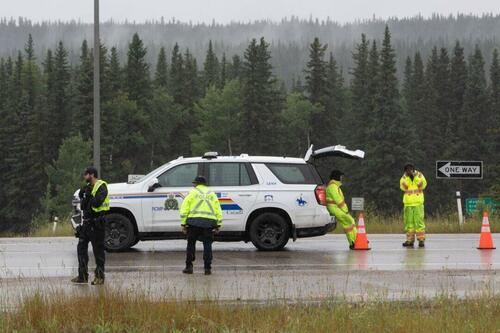
Authored by Cory Morgan via The Epoch Times,
Millions of Albertans, and indeed Canadians, are mourning the destruction of a site where they have memories of recent and childhood trips. We can be thankful that no lives have been lost, but the loss for residents of Jasper is unimaginable. I grew up in the town of Banff and can’t imagine watching my hometown go up in flames.
Banff may very well suffer the same fate as Jasper soon, though, as it is nestled within the same kind of beautiful, but highly flammable Rocky Mountain forests as Jasper. When the Jasper fires have been extinguished and the rebuilding process begins, we must have a serious appraisal of our forest management practices and act as soon as possible. Otherwise, it won’t be a matter of if another community is lost to a wildfire, it will be a matter of when.
The fingers are pointing and the partisan sniping has already begun as politicians and activists try to lay blame of the Jasper tragedy upon others. But we must set aside partisanship, and even ideology, and work towards solutions before we see more losses.
To begin with, it must be accepted that fires in boreal forests are natural and inevitable. It has only been in the last couple of centuries that humans have entered the scene and meddled with the natural cycle of burning and rejuvenation of forests. What we are seeing today is the consequences of deferring the fires that would have naturally burned. The forests have become overgrown, unhealthy, and cluttered with layers of extremely flammable deadfall. Forests in that condition burn hot and fast, leading to fires that can’t be extinguished. Many communities in Canada are surrounded by forests like this and are but one spark away from a disaster.
It’s not reasonable to just let fires burn naturally in populated areas. That means we must manage these forests and our communities to reduce the chances of wildfires and mitigate the damage they cause. This has been done to a degree in areas, but not adequately.
Forest management to reduce wildfire risk is not new. Logging, tree spacing, and prescribed fires are all methods used to reduce fire hazards in populated regions. Unfortunately, when politics get involved, the wisdom of foresters can be lost as elected officials face backlash for supporting the cutting or burning of brush.
Jasper is a prime example. A mountain pine beetle infestation had previously killed thousands of acres of pine trees around the townsite. Standing dead pine trees are extremely flammable, and experts were warning of the risk they presented to Jasper in 2018. A plan was formulated between the Alberta Forest Service and Jasper National Park officials to manage the forests, but it was rejected by the federal government. It’s not that the federal government wanted to see the area burn. They didn’t want to deal with the optics of bulldozers and loggers taking down tracts of forest in a scenic national park along with the haze and smoke prescribed burns would bring. The consequences of that deferral are being seen today.
Municipal governments are loath to create buffers between forests and their townsites because residents enjoy the cozy feel of living next to the wilderness. Developers pitch communities that share space with nature and property owners will complain if bush is cut back.
Cutting buffers in forests, doing prescribed burns, and clearcut logging may not look pretty, but it is all preferable to the devastation a fire will bring. Politicians must make the tough choices and impose fire mitigation measures upon communities, even if it upsets some residents.
Just as we build dams and dykes to prevent flooding in populated areas, we must look at managing forests to reduce the fire risks. I worked as a surveyor for over 20 years in Alberta, and what I saw building up on the eastern slopes of the Rocky Mountains was concerning, to say the least. In some areas, it is almost impossible to walk due to the volume of deadfall. If we don’t clear those zones out soon, a fire will and it will be a big one.
Government jurisdiction and long-term changes in the climate are subjects worthy of discussion, and we doubtless will be having those discussions for years.
In the meantime, we must act and safeguard our communities. We don’t have years to wait, and we will see more heartbreaking losses as we have with Jasper if we keep putting off the forest management that must happen.
Authored by Cory Morgan via The Epoch Times,
Millions of Albertans, and indeed Canadians, are mourning the destruction of a site where they have memories of recent and childhood trips. We can be thankful that no lives have been lost, but the loss for residents of Jasper is unimaginable. I grew up in the town of Banff and can’t imagine watching my hometown go up in flames.
Banff may very well suffer the same fate as Jasper soon, though, as it is nestled within the same kind of beautiful, but highly flammable Rocky Mountain forests as Jasper. When the Jasper fires have been extinguished and the rebuilding process begins, we must have a serious appraisal of our forest management practices and act as soon as possible. Otherwise, it won’t be a matter of if another community is lost to a wildfire, it will be a matter of when.
The fingers are pointing and the partisan sniping has already begun as politicians and activists try to lay blame of the Jasper tragedy upon others. But we must set aside partisanship, and even ideology, and work towards solutions before we see more losses.
To begin with, it must be accepted that fires in boreal forests are natural and inevitable. It has only been in the last couple of centuries that humans have entered the scene and meddled with the natural cycle of burning and rejuvenation of forests. What we are seeing today is the consequences of deferring the fires that would have naturally burned. The forests have become overgrown, unhealthy, and cluttered with layers of extremely flammable deadfall. Forests in that condition burn hot and fast, leading to fires that can’t be extinguished. Many communities in Canada are surrounded by forests like this and are but one spark away from a disaster.
It’s not reasonable to just let fires burn naturally in populated areas. That means we must manage these forests and our communities to reduce the chances of wildfires and mitigate the damage they cause. This has been done to a degree in areas, but not adequately.
Forest management to reduce wildfire risk is not new. Logging, tree spacing, and prescribed fires are all methods used to reduce fire hazards in populated regions. Unfortunately, when politics get involved, the wisdom of foresters can be lost as elected officials face backlash for supporting the cutting or burning of brush.
Jasper is a prime example. A mountain pine beetle infestation had previously killed thousands of acres of pine trees around the townsite. Standing dead pine trees are extremely flammable, and experts were warning of the risk they presented to Jasper in 2018. A plan was formulated between the Alberta Forest Service and Jasper National Park officials to manage the forests, but it was rejected by the federal government. It’s not that the federal government wanted to see the area burn. They didn’t want to deal with the optics of bulldozers and loggers taking down tracts of forest in a scenic national park along with the haze and smoke prescribed burns would bring. The consequences of that deferral are being seen today.
Municipal governments are loath to create buffers between forests and their townsites because residents enjoy the cozy feel of living next to the wilderness. Developers pitch communities that share space with nature and property owners will complain if bush is cut back.
Cutting buffers in forests, doing prescribed burns, and clearcut logging may not look pretty, but it is all preferable to the devastation a fire will bring. Politicians must make the tough choices and impose fire mitigation measures upon communities, even if it upsets some residents.
Just as we build dams and dykes to prevent flooding in populated areas, we must look at managing forests to reduce the fire risks. I worked as a surveyor for over 20 years in Alberta, and what I saw building up on the eastern slopes of the Rocky Mountains was concerning, to say the least. In some areas, it is almost impossible to walk due to the volume of deadfall. If we don’t clear those zones out soon, a fire will and it will be a big one.
Government jurisdiction and long-term changes in the climate are subjects worthy of discussion, and we doubtless will be having those discussions for years.
In the meantime, we must act and safeguard our communities. We don’t have years to wait, and we will see more heartbreaking losses as we have with Jasper if we keep putting off the forest management that must happen.
Loading…






